![]()
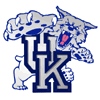 | 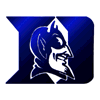 |
![]()
[Link to All-Time Series Results]
The series between Kentucky and Duke (Kentucky currently leads 12-10) is one which is made up of relatively few games, however this is more than made up by the sheer number of late-second heroics, stellar plays, tense moments and high profile matchups which have come to personify the series between these two schools.
Over the course of these games, the two have matched up for one national title game, one NCAA semi-final, two NCAA regional finals, one NCAA Sweet-Sixteen, two Hall of Fame Tip-Off Classics, one UKIT Championship (along with the inaugural UKIT game), two Jimmy V Classic games, two Champions Classic games and one Sugar Bowl Championship among others. And of those games, no fewer than 12 came down to the final minutes before the game was decided, with a number of those coming down to last-second shots. Included in that mix is one game in particular which has been described by many as the greatest game ever played.
![]()
Game by Game Review
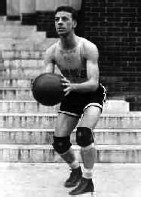 |
| Duke's Bill Werber |
The game itself was fast for its day, and the score was close throughout. Duke led at halftime by a single basket 20-18, but the Wildcats came back from intermission to forge ahead. Just when it appeared Kentucky would take the game over, leading by 4 points, Croson hit a shot for Duke and was fouled by Combs in the process. Apparently in that day and age, two shots were awarded on a shooting foul regardless of whether the field goal was good or not. Croson made both of his charity tosses and with this 4-point play, Duke was again tied with Kentucky. This play was enough to turn the tide, and Duke went on to build a big lead and win the game, although Kentucky made it interesting by coming back from an 8-point deficit to close to within 3.
Morgan Blake, the senior columnist for the Atlanta Journal (who had reported on all the Southern Conference tournaments going back to the beginning) described the game at the time as "the greatest basket ball game ever played in Atlanta." This game would serve as a fitting precursor to the games to come.
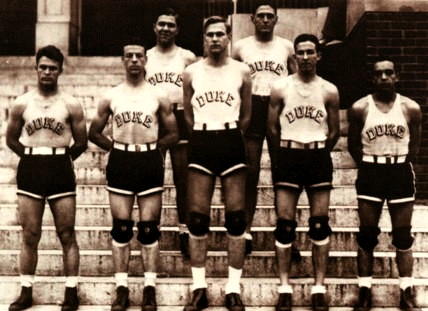 |
| 1930 Duke Blue Devils - Front Row (l to r): Boley Farley, Bill Werber, Joe Croson, George Rogers, Harry Councilor. Back Row: Donald Burch, Bob Thorne |
[Boxscore] - 1930 Southern Conference Tournament
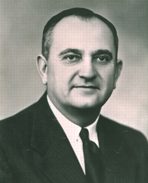 |
| Adolph Rupp |
Joe Croson returned for Duke, and scored 11 points to lead the Blue Devils. But gone were his experienced running mates Werber and Councillor from the previous year, and his efforts weren't enough to overcome Kentucky. The Wildcats got off to a big lead at the start of the game, 11-2, based in no small part on controlling the tip-off which occurred after every made basket. Only after Duke solved the tip-off problem did they have a chance to make head-way. Trailing by 13 at the half, Duke steadily chipped at the lead, however the scoring of "Little" Louis McGinnis and the efforts of Carey Spicer kept UK out of reach and Kentucky went on to win the game 35-30.
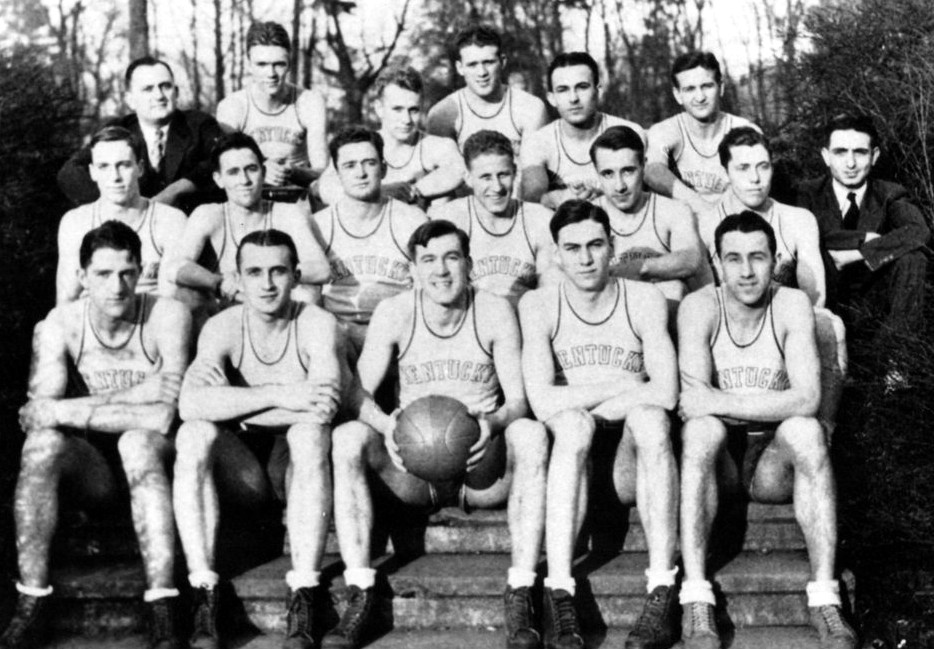 |
| 1931 Kentucky Wildcats - Front Row (l to r): Ercel Little, George Yates, Carey Spicer, Forest Sale and Milton "Bud" Cavana. Middle Row: George Skinner, Allan Lavin, Bill Trott, Jake Bronston, Louis McGinnis, Cecil Bell and manager Morris Levin. Back Row: Coach Rupp, William Congleton, Bill Kleiser, Ellis Johnson, Charles Worthington and Darrell Darby |
[Boxscore] - 1931 Southern Conference Tournament
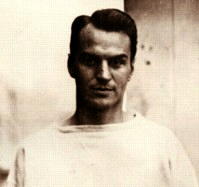 |
| Eddie Cameron |
As a sidenote, in the game story was mentioned that the following day, Coach Rupp took the Blue Devil team on a tour of Lexington and the surrounding area. This is noteworthy, not because it was unusual at the time (in fact this type of thing was done by Rupp regularly during his career), but because it is so foreign to the way modern teams conduct themselves. Back then, if a team made the effort to take a train to a far-away place, they certainly were going to make the most of it. This is completely opposite of modern-day teams which jet from city to city, often with no opportunity to identify with the local scene, let alone having the opposing coach being the one conducting the tour.
[Boxscore] - 1931-32
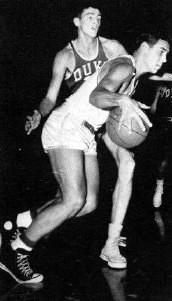 |
the Duke defense |
 |
Duke entered the game ranked #8 in the nation, but they faced a Kentucky team which was formidable, with two players (Frank Ramsey and Cliff Hagan) who not only were All-Americans, but would go on to be inducted into the Basketball Hall of Fame. The game was tight until the end of the third quarter when Kentucky, leading by a 49-47 score, went on a 21 to 4 run to blow the game open. Hagan scored a game-high 27 points while Ramsey added 19. Duke was paced by 14 points each from Bernie Janicki and Ronnie Mayer and 12 points from Joe Belmont. Kentucky went on to the UKIT Championship where they defeated a LaSalle team which would go on to win the national title that year.
Kentucky finished the season undefeated at 25-0, but did not participate in the NCAA Tournament that year. At the time, graduate students were not allowed by the NCAA regulations to compete in the tournament, even if they had basketball eligibility left and played in the regular season. Kentucky appealed the regulation, claiming the rule only hurt those who were forced to stay out of competition for reasons beyond their control, but still did the right thing and graduated in four years (or graduated in shorter time periods). In UK's case, the players had sat out the 1952-53 season when the SEC and then NCAA forced Kentucky to cancel its entire schedule as penalty for a point shaving scandal which occurred with players who were no longer at the school. Kentucky's appeal was denied prior to the start of the NCAA Tournament, and it was decided by the coaching staff not to compete if they couldn't use all their players. Despite this, the undefeated 1954 UK team was awarded the National title as determined by the Helms Committee (a private entity) in recognition of their achievements. The rule forbidding graduate students from competing in the NCAA Tournament was later rescinded by the NCAA.
[Boxscore] - 1953-54
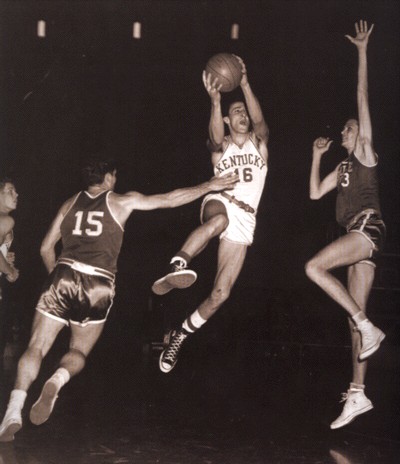 |
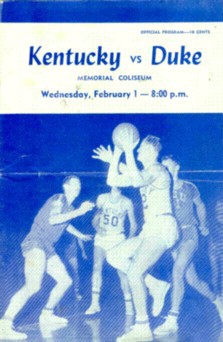 |
Kentucky flirted with blowing the game open in the second half but each time the Blue Devils staged a comeback to cut the lead. Said the Lexington Herald, "Five times in the last half Coach Adolph Rupp's Wildcats appeared well on their way to a decisive victory over the Atlantic Coast Conference team, but each time Duke came battling back and at the finish had the Wildcats hanging on the ropes and the spectators hanging limply to their seats. And the officials came dangerously close a hanging too."
Kentucky was ahead by 17 in the second half when the Blue Devils went on a 19-4 tear which brought the margin to 71-66 with a little over four minutes to play. Kentucky was able to hit their free throws down the stretch and the game was secured at 81-76. Bird led Kentucky with 29 points, a total matched by Joe Belmont of the Blue Devils.
[Boxscore] - 1955-56
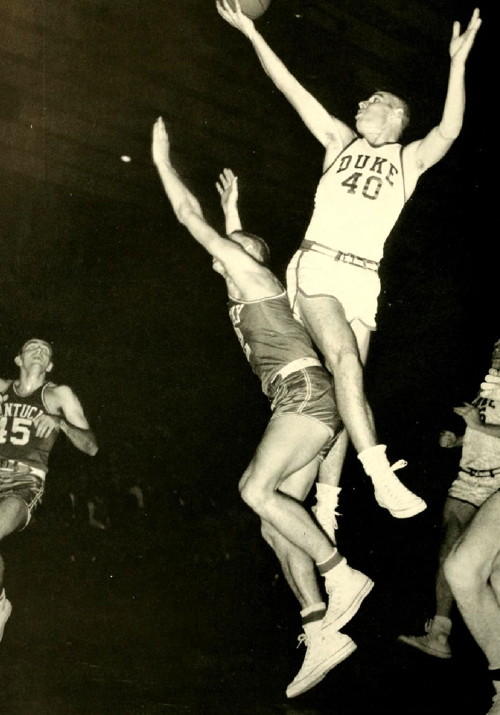 |
| Duke's Bucky Allen tries to score over a UK player |
The crowd was so excited by the outcome that they rushed the court, which effectively prevented a last-second foul shot by Duke from being completed. Cox and Vernon Hatton led Kentucky with 22 points apiece. Jim Newcome led the Blue Devils with 21 points, while Allen added 20. Lamented Coach Rupp, "We were stupid and Duke was smart . . . we have only ourselves to blame."
Immediately after the game, the Wildcats left on a chartered flight but only a few minutes after they lifted off the plane developed engine problems, prompting the team to make an unexpected landing in nearby Greensboro N.C.. The team ended up staying in the city overnight before returning to Lexington the following morning.
A few weeks later, Kentucky Coach Rupp lodged a formal complaint about the officiating in the game, in particular protesting the nullification of a Adrian Smith free throw by ACC official Phil Fox which Rupp felt proved to be the difference in the game. Noted Rupp: "Coaches are instructed to wait until the next ay after a game to protest a play. I waited 21 days before protesting to Commissioner Bernie Moore and to the officials," (Phil Fox of the Atlantic Coast Conference and Louisville's Max Macon, it was Fox who made the controversial call). "I think something should be done about the officiating. . . It's a shame that the University pays me a pretty good salary, spend about $20,000 in scholarships and then turns our games over to officials to butcher up the play. We work hard two hours every day and then everything we have worked for can be undone by an official in 40 minutes."
Ed Ashford in an article the day after the game questioned the play:
"Did the officials goof in the Kentucky-Duke game last night and thereby possibly cost the Wildcats a victory? Wildcat supporters couldn't understand their decision when they erased a free throw by Adrian Smith and forced the reserve Cat guard to shoot again.
Kentucky was leading, 78-73, with 6:10 to play when Smith was fouled. As he dropped in the first shot, Duke's Paul Schmidt ran onto the floor to replace Jim Newcome. The officials nullified Smith's point, and had him shoot again when play was resumed.
Smith missed, and Duke got the ball and scored a quick basket to cut the UK lead to 78-75. Had Smith's first shot been good, he would have had another coming. At any rate, Kentucky lost at least one point - Duke's margin of victory - by the questionable decision. Even one more point would have been mighty sweet last night.
After the incident, official Phil Fox said he ruled Smith's shot 'no try because the shooter didn't know Duke had six men on the floor,' According to Rule 10, Section 5, which states: 'A substitute shall not enter the court without ... being beckoned by an official' a technical foul should have been called on Schmidt, since the ball already had been placed in Smith's hands when Schmidt ran onto the court. So instead of a possible three points and possession of the ball, the Cats got no points and lost possession."
[Boxscore] - 1956-57
 |
| Architect's Rendering of Duke Indoor Stadium |
If any of the 12,000 fans at Memorial Coliseum doubted the heroics of the previous year could be equaled, they were pleasantly surprised when the two teams faced off in December of 1957. Kentucky held a 6-point lead at halftime and were able to extend that to seven points with 5:38 remaining. But, as with the previous year, the Blue Devils stormed back and went ahead 74-73 on a lay-up by Bucky Allen with a little over two minutes to play. This time, Kentucky responded. UK coach Adolph Rupp designed a play for senior Vernon Hatton which resulted in a field goal which put Kentucky back on top. Along with some Duke miscues, Hatton converted three free throws to hold the advantage and UK won the game 78-74. Hatton led all scorers with 26 points. Bucky Allen and Bob Vernon led the Blue Devils with 17.
As a sidenote, this would not be the last time Hatton would be called upon to be a hero that year. Later in the week, Kentucky would face Temple on the same floor and Hatton would make one of the most 'clutch' shots ever in Kentucky history (a last-second 47-foot desperation bomb from half-court), to send Kentucky into the second of three overtime sessions and eventually win the game. Later, Hatton would play a major role in Kentucky's successful drive for an unlikely national title.
[Boxscore] - 1957-58
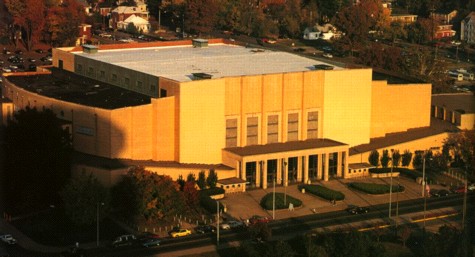 |
| Kentucky's Memorial Coliseum |
The final game of this four-game series found Kentucky returning to Durham. The game was tight in the second half, with Kentucky leading by only 3 points with 11 minutes left. However, after that point, Kentucky spurted ahead on jump shots by All-American Johnny Cox and Sid Cohen. Duke fouled the UK players, however Kentucky made their free throws and the game ended with a 14-point margin. Cohen led the Wildcats with 19 points. Carroll Youngkin led Duke with 17.
[Boxscore] - 1958-59
As the 1960's came round, the two programs took a break from meeting on a regular basis. It was during this time that Duke started to make national inroads for the first time. Their young coach Vic Bubas came to Durham from Raleigh where he was an assistant coach under Wolfpack mentor Everett Case. Bubas' first squad reached the regional finals of the NCAA Tournament. With All-American players in Art Heyman and later Jeff Mullins, Bob Verga and Jack Marin, Duke became a legitimate national power in the 1960's and participated in three final fours.
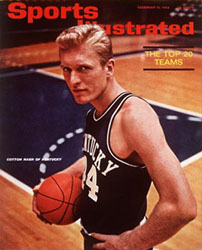 | 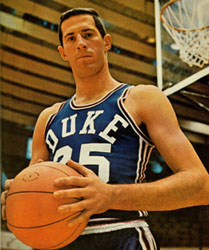 |
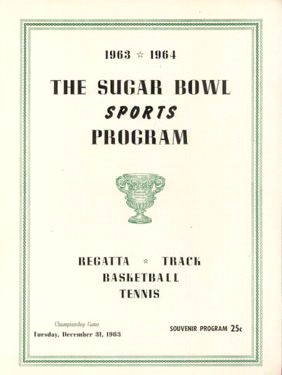 |
 |
Time-out was called and Kentucky set up for a last shot. The All-American Nash was supposed to take the shot, but he was well covered by Duke defenders and the ball found the hands of Mobley once again. Mobley launched a shot from near the free-throw line with only a few seconds remaining. The basket proved to be the ballgame. On a humorous side, Mobley relates that after the winning basket went in, Rupp (who normally did not come out onto the court) hurried toward the hero of the moment. Never one to shy away from potential publicity or afraid to make himself look good in the media, Rupp reportedly told Mobley, "Remember, Harrodsburg, we knew Duke was expecting Nash to get the ball, so we outsmarted them and instructed you to take the last shot." Mobley remembers that the following day at least one New Orleans newspaper was hooked with the headline "RUPP SURPRISES DUKE - CALLS ON MOBLEY TO TAKE THE WINNING SHOT."
Nash led the Wildcats with 30 points and Deeken added 18. Duke was led by Hack Tison (with 27 points) and Jeff Mullins (with 26 points). Reminisced Nash on the game many years later, "I earned MVP for my 30-point effort and the next day we were No. 1 in the country in the UPI Poll. In the morning we could hardly button our shirts as our chests swelled with pride. It was the first time in several years that Kentucky had reached No. 1 in the nation. It was an unforgettably good feeling."
[Boxscore] - 1963 Sugar Bowl Tournament
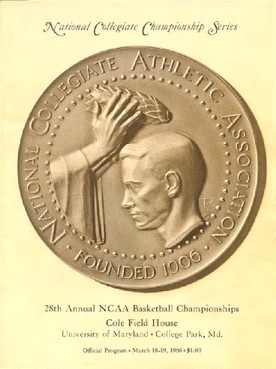 |
Kentucky got off to a fast start in the game, as they used their quickness and outside shooting to easily break down Duke's zone. As the Blue Devils adjusted their defense, Kentucky soon went into a shooting slump and Duke was able to pull back into the game and lead at halftime by a single point.
The second half proved exciting, with the score being tied six times. UK's Larry Conley played a valiant game, despite recovering from the flu. Said Coach Rupp, "He had a 102-degree fever last night... but we fixed that with some old-fashioned goose oil and a vaporizer." Late in the game Conley grabbed a rebound and dribbled the full length of the court to score a critical basket which put Kentucky ahead 79-72, and sealed the victory. Conley wasn't the only sick player. Duke's All-American Bob Verga had also been ill earlier in the week with what was thought to be tonsillitis and only scored 4 points. Duke's other All-American, Jack Marin, led all scorers with 29 points to lead the Blue Devils. All-American Louie Dampier led Kentucky in scoring with 23.
The hype surrounding the game proved for naught, as the next night UK went on to lose the game against an unheralded (but #3 ranked) Texas Western squad for the National Championship. The championship game is considered a landmark game, as it is the first and likely only time a team consisting of only white players faced a team of only black players in the NCAA title game (Texas Western had white players on its roster, however none of them saw minutes in the final game). Kentucky would be stuck with the stigma of being the team which had only white players at the time, despite the fact that Rupp had been one of the first Southern coaches to offer a scholarship to a black player when he recruited Wes Unseld in 1964. As it turns out, the Duke squad was completely comprised of white players that year also. If the Blue Devils had won the game the night earlier, they might have gone down in history with that stigma instead of Kentucky.
 |
| Louie Dampier speeds around a Thad Jaracz pick |
[Boxscore] - 1966 NCAA Final Four
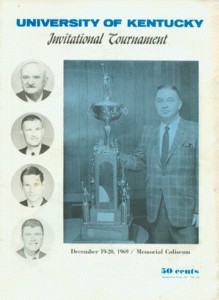 |
Kentucky was ranked #1 at the time and proved too much for the Blue Devils and their young coach, Bucky Waters, although it still wasn't easy. With 12:54 left in the game, Kentucky clung to a four-point lead while their All-American center, Dan Issel, left the action with four fouls. In order to compensate for the loss of Issel, Rupp went against his own philosophy and switched to a zone defense. This move proved to be the difference as Kentucky steadily outscored Duke from that point on and finished with a 22-point victory. Randy Denton, Duke's center, outplayed Issel for much of the night and finished with 28 points and 21 rebounds. Kentucky was led by Mike Pratt with 26 points and little-known guard Bob McCowan with 25. This proved to be McCowan's career high at Kentucky.
[Boxscore] - 1969-70
After all the high-profile matchups between the two schools, the matchup for the biggest prize of all still remained. This was realized in 1978 when #1-ranked Kentucky met #7-ranked Duke for the national title in St. Louis' Checkerdome. The matchup was intriguing, with the experienced, physical and all-business Wildcats going against a young, happy-go-lucky group of Blue Devils led by Bill Foster. Joe B. Hall was the head coach of Kentucky, having taken over for Adolph Rupp in 1972, after Rupp had been forced by the University to retire.
The game was tight throughout, with Kentucky never able to break away. Duke played a soft zone which, as with the game in 1966, Kentucky was able to exploit. With the Blue Devils having to check UK All-American big-man Rick Robey on the inside and still track UK's guards Kyle Macy and Truman Claytor on the perimeter, UK's All-American forward Jack "Goose" Givens found room in the middle of the zone where he was able to launch his medium-range jump shots. Duke was never able to adjust well enough to shut Givens down and he continued to score throughout the contest. Givens was so hot that at one point, he shot from the baseline and the ball somehow found the backboard and banked in ! (A shot which 25 years later, he was unable to recreate for his son after they watched a tape of the game.) Duke stayed close by shooting an amazing 20 of 21 free throws in the first half (30 of 34 for the game).
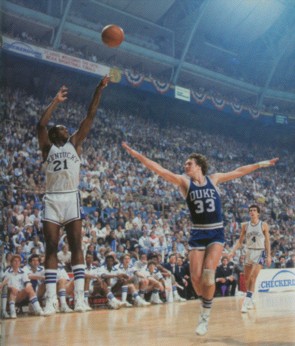 |
| Jack Givens Shoots |
Despite a 7-point halftime lead, Hall lit into his squad, trying to guard against complacency at the critical time. He reiterated the game plan of attacking the middle of the zone, saying to his team, "I guarantee you that they cannot guard you right here," as he pointed to a spot on the blackboard.
A critical moment early in the second half helped Kentucky's fortunes, as Foster was tagged with a technical foul for overly protesting what he considered to be a walk by UK's Truman Claytor. Kyle Macy hit the resulting free throws and this signalled a spurt which put Kentucky in control of the game, or so they thought. With less than a minute remaining and a seemingly comfortable lead, Hall decided to pull his starters to give the fans a chance to show their appreciation. But Duke responded to this move by pressing. Duke scored quickly on a jump shot by Mike Gminski which closed the gap to only four points. Said Robey after the game, "They didn't quit. . . They're a young team, and I thought when we had them down like that, they might give up. But they just kept fighting back."
Hall called time-out, rushed his starters back into the game, and the victory was sealed when senior forward James Lee received a long pass and rushed past Duke's Bob Bender for a last-second breakaway slam-dunk. It was a fitting ending to a tremendous career for the Kentucky seniors. They were finally making good in the NCAA championship game, after missing a chance (as freshmen) against UCLA in 1975 in the last game John Wooden coached.
 |
| James Lee with the Exclamation Point |
Givens finished with 41 points on the night. His career high and third all-time in NCAA championship game history behind Bill Walton's 44 and Gail Goodrich's 42 (both of UCLA). Said Jim Spanarkel after the game, "Givens played as fine a game an any player I've ever gone against. He was as hot as could be. I guess we played him on a night when we shouldn't have." Rick Robey added 20 points and 11 rebounds for Kentucky. Gene Banks led Duke with 22 points, while Jim Spanarkel added 21 and Gminski 20.
[Boxscore] - 1978 NCAA Championship
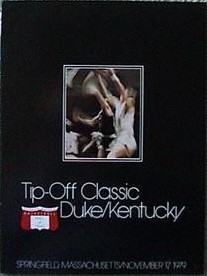 |
The game marked the unveiling of UK's much-heralded big man recruit Sam Bowie (among others in a stellar recruiting class), and he did not disappoint. The 7-1 foot freshman scored 22 points and grabbed 17 rebounds, and for much of the game outplayed his more experienced foe in Gminski.
Duke got off to a fast start and held a 26-14 lead part-way through the first half. It was then that Kentucky started to make their move, largely on the backs of Bowie and senior LaVon Williams. Kentucky came back to produce a 21-point turnaround and when Dwight Anderson scored a layup to put UK ahead 65-56 with a little over nine minutes remaining, the Wildcats looked to be in control. But from then on, it was Duke's turn to stage their comeback which they accomplished by tying the score at 72-72 and sending the game into overtime on a Bob Bender layup. Bowie missed the front end of a one-and-one with the Wildcats holding a 72-70 lead and with 15 seconds remaining in regulation. "I guess I choked" said the freshman big man. Kentucky shot poorly (not hitting another field goal in regulation) and committed five turnovers in the final six minutes of play, and another five in overtime. With Banks and Dennard out of the game on fouls, Gminksi came alive in the overtime, at one point scoring five consecutive points, and Duke went on to win the game.
[Boxscore] - 1979-80 Tip-Off Classic
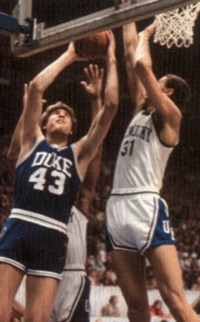 |
But as with the earlier contest, Duke ran out to a big lead. And just as with the earlier contest, Kentucky made their comeback. With Bowie fouled out, it was UK junior Fred Cowan who took over the scoring duties as he contributed Kentucky's final 15 points of the game. Cowan scored a field goal with 37 seconds left to tie the score at 54-54. Duke's Gene Banks hit one of two free throws in what would prove to be the final margin. But this was not before Kentucky had one last attempt to win the game. After a time-out with nine seconds left, Kentucky senior Kyle Macy, with Duke's Vince Taylor guarding closely, saw no other option and forced an 18-foot shot which missed. That was the ballgame. The hometown fans screamed for a foul but no call was made. Said Taylor, "I put my hands straight up and there definitely was contact. . . People will say I fouled him and I didn't think I did. He fell into me after the shot, and the defensive man has to have some advantages."
[Boxscore] - 1980 NCAA Tournament
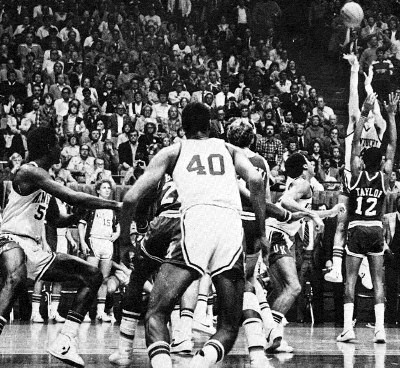 |
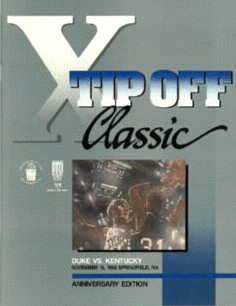 |
The game was tight throughout the first half, with Duke holding a 2-point edge at halftime. But soon the dam burst after UK's center LeRon Ellis sat down with 4 fouls and Duke went on a 16-0 run, fueled by two Danny Ferry 3-pointers. Ferry ended with 23 points on the night. Ellis led Kentucky with 17 points. The final score showed a 25 point margin, and it presaged Kentucky's first losing season in 62 years. But that was the least of UK's troubles. The next time these two programs would meet three and a half years later, Kentucky would just be reemerging out of the darkness for the first time.
[Boxscore] - 1988-89 Tip-Off Classic
And so we come to what many consider to be the greatest game of all-time. Held in Philadelphia's Spectrum in the NCAA East Regional, it is this night that college basketball fans (let alone Duke and Kentucky fans) will remember where they were and how they felt for a long time to come.
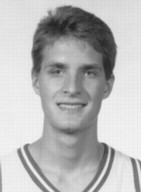 |
Kentucky was led by the charismatic Rick Pitino, who took over the team in the wake of a scandal which ravaged the entire athletic department. What he found when he arrived was the left-overs from what was promised to be a powerhouse. With players like LeRon Ellis, Chris Mills, Eric Manuel etc. either jumping ship or barred from playing at UK (and in the case of Manuel playing anywhere), the program was at a historic low. Many of the remaining players on the squad were originally intended to be bench warmers or role players, and simply had no other option but to stick it out through the dark years of probation.
Reminiscent of Adolph Rupp's teams, Pitino believed in a fast-paced attack to which he added the full-court pressure defense and a smart three-point shooting strategy based on quick passing, ball movement and floor spacing. Although the players were not extremely athletic and not ideally suited for the system, Pitino made the most of what he had and in some cases, made shooters out of players who until then were strictly post-players (ie Reggie Hanson, Deron Feldhaus). With the help of a talented sophomore in Jamal Mashburn, UK reached heights no one (let alone their demanding fans) ever expected them to reach so soon.
By 1992, the squad had been deeply immersed in the Pitino philosophy and when they were finally allowed to compete in the NCAA Tournament, they were primed and ready. For the four seniors who stuck through the dark times and bore the brunt of the abuse for the sins of others: Sean Woods, John Pelphrey, Deron Feldhaus and Richie Farmer, this would be their one and only chance to shine on a national stage.
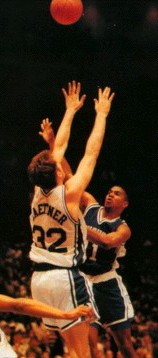 |
The Kentucky players responded and scored eight straight points within a minute, with the major contribution coming from two three-pointers from Jamal Mashburn. From that point on, the game took on a new sense of urgency that continued to build with every passing moment. Both teams raised their game and made key basket after key basket. Laettner was hitting every shot he tossed toward the goal and Bobby Hurley hit a number of clutch three-pointers and Duke once again pushed the lead out to 10. But Kentucky simply would not go away and they scratched their way back into the game. With the seconds ticking down and the score tied, Bobby Hurley had a chance to win the game, but like Kyle Macy before him, he was unable to connect. The game went into overtime.
Jamal Mashburn led Kentucky with 28 points, and converted a 3-point play in overtime to put Kentucky ahead. But with only 14 seconds left, he was called for his fifth foul on a shot by Christian Laettner and had to leave the game. Laettner converted both free throws, putting Duke back in the lead. If Kentucky was going to win, it would be up to the seniors.
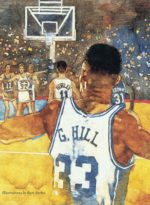 |
But unfortunately for Kentucky fans, the story doesn't end there. After a time-out and with 2.1 seconds remaining, Duke still had a last chance. Grant Hill threw a perfect three-quarter length pass to Laettner who faked, dribbled once, turned and then shot the perfect game winner with no time left on the clock. It was an amazing ending to an amazing game.
[Boxscore] - 1992 NCAA Tournament
The game in 1992 was such a classic that it resonated among Kentucky and Duke fans alike for years, and still does. A rematch was long anticipated, and could never live up to the drama (and the subsequent hype) which became associated with the earlier game. But when the rematch did occur, it actually came close. The site of the rematch which occurred six years later was Tropicana Field in St. Petersburg Florida.
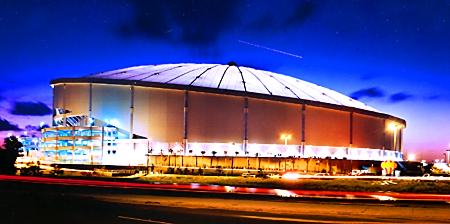 |
Once again, the two teams met in the NCAA Regional Final, with the winner gaining entrance to the Final Four. Kentucky was riding high, having won a national championship in 1996 and losing in the NCAA finals in overtime in 1997. Rick Pitino was gone, but one of his former assistants, Orlando "Tubby" Smith was hired away from Georgia to lead the program. The team was without some of their talented stars from past years, but by tournament time, the experienced Wildcats were again showing the form which helped them storm through past tournament fields. Duke was ranked #3 in the country and were led by Trajan Langdon and William Avery, along with a highly-touted freshman class in Elton Brand and Shane Battier, among others.
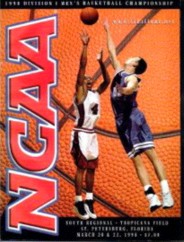 |
The rest of the game was tight, with each possession critical. So critical in fact that during a scramble with six minutes remaining, McLeod called a timeout to maintain possession; the timeout was Duke's last. This proved crucial during the rest of the game, as the experienced Kentucky players began to make plays while coach Krzyzewski, without a timeout to help stem the tide, could only yell from the sidelines as his young players struggled to adapt. With Kentucky trailing 79-77, UK's Heshimu Evans (surrounded by Duke players) batted the ball out to the perimeter to former walk-on Cameron Mills who promptly nailed a three pointer which put Kentucky ahead for the first time in the game. Free throws by Duke's McLeod and Kentucky's Scott Padgett left the game again knotted at 81. But Kentucky got the ball back and Padgett hit another critical three-pointer which gave UK the upper hand.
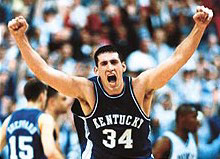 |
With the seconds ticking away, Duke finally was able to hit a late-game three-pointer, but that still left Kentucky ahead with a score of 85-84. Allen Edwards was fouled by Duke with 5 seconds remaining and he made one of two free tosses. In a situation eerily reminiscent of the 1992 contest, Duke had a chance to tie or take the lead with only a few seconds remaining. However this time the long pass was well guarded and Duke settled for throwing short to William Avery to see if he could use the 4.5 seconds to get a closer shot at the goal. Avery was able to dribble to about half-court, but his fling landed off-the-mark and Kentucky was once again returning to the Final Four. The Wildcats would go on to win the National Title that year, but had to come back from large deficits in both of their Final Four games, cementing their nickname "The Comeback Cats."
[Boxscore] - 1998 NCAA Tournament
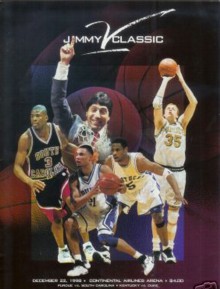 |
Kentucky remained competitive in the first half, despite foul trouble by UK starter Scott Padgett. Kentucky trailed 39-34 at the break. However, at the beginning of the second half, Duke sped out to a 50-34 lead and never looked back. The Wildcats shot only 35% from the field and never threatened.
Elton Brand led all scorers with 22 points and Trajan Langdon added 18 for Duke. Kentucky had a balanced scoring effort, with Scott Padgett and Heshimu Evans each contributing 13 points.
[Boxscore] - 1998-99 Jimmy V Classic
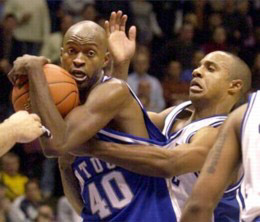 |
| Jules Camara and Jason Williams Battle for a Rebound |
Despite the onslaught by Williams, Kentucky held tough and went ahead by one point with 17 seconds left on a clutch shot by UK's Tayshaun Prince. Duke had a chance to win the game in regulation when Prince was called for a foul on Williams. Williams, however, made only one of two free throws and after an errant last-second shot by Kentucky's Cliff Hawkins, the game went into overtime.
The overtime was just as tense as the final minutes of regulation. Duke's Michael Dunleavy scored seven straight points to pace the Blue Devils in overtime. Kentucky tied the score late in the extra period and even took the lead for a brief moment, however Duke persevered and took home a hard-fought victory.
[Boxscore] - 2001-02 Jimmy V Classic
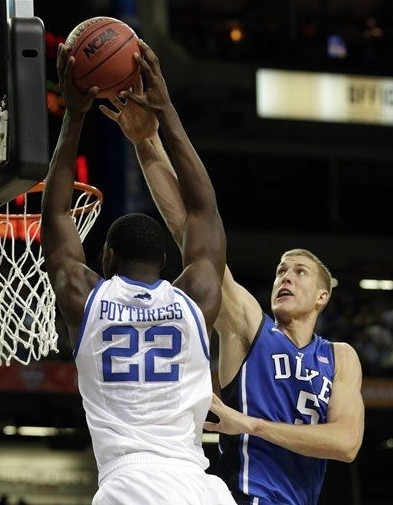 |
| Alex Poythress #22 tries to power a dunk by Duke's Mason Plumlee #5 |
The two teams met in Atlanta, the city where the series began. Kentucky, who was coming off the 2012 National Championship but was a nearly entirely different team and extremely young, entered the game ranked #3 in the country. Duke was a much more experienced team but ranked #9.
The game was tight, with the halftime score 33-31 in favor of Duke. With their star Mason Plumlee on the bench in foul trouble, the Blue Devils were still able to go on a 11-5 run, and extended the lead to as many as 14 in the second half. Duke was able to score from the perimeter, shooting 8-18 from three-point range, with Seth Curry and Rasheed Sulaimon contributing three each.
But the Wildcats came back, cutting the lead to three points, first 64-61 with 3:29 and then 66-63. But Seth Curry scored a critical basket with just a 1:09 to play, to put the Blue Devils back up by five, securing the victory.
Curry ended up scoring 23 points for the Blue Devils, six of which came in the final two minutes of the game. He was followed by Mason Plumlee who scored 18 points before fouling out.
For Kentucky, freshman Alex Pothress had a breakout game with 20 points on 9-12 shooting (with many of them monster dunks) while fellow freshmen Archie Goodwin (who was playing out of position at point guard in place of Ryan Harrow who was ill) and Nerlens Noel contributed career-high 16 points apiece.
[Boxscore] - 2012-13 Champions Classic
Three years later the two teams faced each other in the Champions Classic, this time in Chicago at the United Center.
The two teams were young, but ranked in top-5, UK ranked #2 while Duke was ranked #5 by the Associated Press.
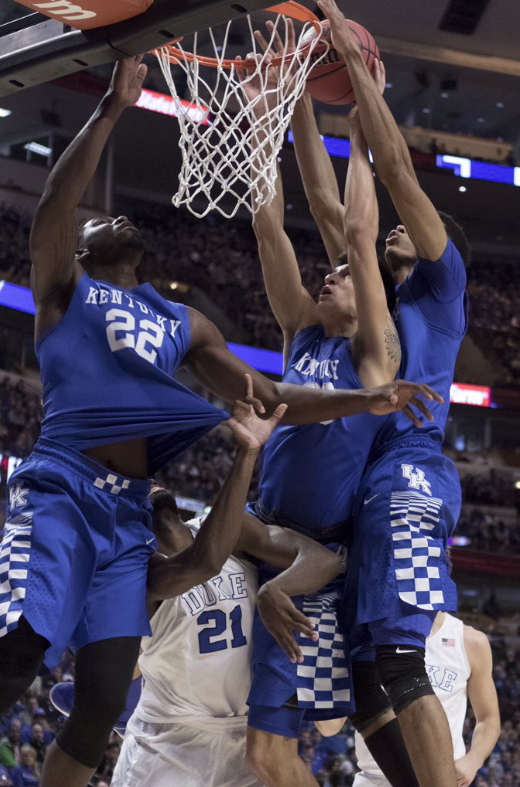 |
Early in the second half, Kentucky went on a 10-2 run, fueled by their trio of guards, Tyler Ulis, Jamal Murray and Isaiah Briscoe. Kentucky's guards ran rings around Duke's guard, out-scoring their counterparts 18-4 on fast break points.
For Kentucky, Tyler Ulis led the Wildcat scoring with 18 points and 6 assists while his backcourt mate Jamal Murray added 16 points and 5 assists.
Kentucky's Alex Poythress, who was coming back from a serious injury during the previous season, played an important defensive role scoring nine points and grabbing seven rebounds. Despite still being rusty from his year off, Poythress at times showed the athleticism he was known for, at one point chipping his tooth on the rim after finishing a lob dunk from Murray. Poythress was the only UK player to have played in the previous Duke Champions Classic game in 2012, the game where he had his 20-point coming out party as a freshman.
For Duke, Amile Jefferson (who also played in the 2012 game for Duke) scored 16 points and grabbed 15 rebounds to co-lead the Blue Devils in scoring with Matt Jones. Duke star Grayson Allen was limited to six points on 2-11 shooting.
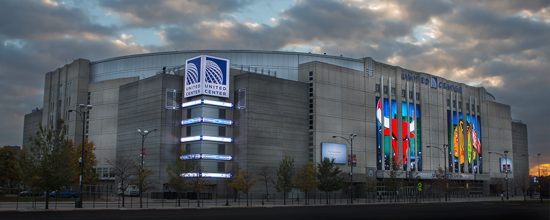 |
[Boxscore] - 2015-16 Champions Classic
Three years later the two met again in the Champions Classic, this time at the Bankers Life Arena in Indianapolis. There was much anticipation of the game for the two teams both ranked in the top five preseason (Kentucky rated #2 and Duke #4 by the Associated Press). The excitement was especially high in that in the interim, Duke's Mike Krzyzewski took a page from John Calipari and recruited highly touted players who were destined to be "One-and-Done", leaving for the NBA after only one year in school.
Duke had landed three highly touted players: R.J. Barrett, Cam Reddish, and Zion Williamson, three of the top five-rated recruits in the nation. In addition, big man Marques Bolden had signed with the Blue Devils after many Kentucky fans thought he was destined to play for the Cats.
For their part, the Wildcats as usual signed a talented but young class, albeit not as highly rated as Duke's. This included Ashton Hagan, Immanuel Quickley, Keldon Johnson, Tyler Herro and E.J. Montgomery. In addition, the Wildcats picked up big man Reid Travis as a Grad Transfer from Stanford. Unlike many previous Kentucky teams under Calipari, the team did have returning talented experience in the form of sophomores P.J. Washington, Nick Richards and Quade Green.
But the experience didn't help Kentucky as the Duke freshmen ran roughshod over the Wildcats. Duke rushed out to a 22-10 lead and never looked back, the game was never in doubt. Most of the damage came at the hands of R.J. Barrett who drove to the rim with impunity while shooting 3 of 7 three pointers, leading the game scoring with 33 points. Meanwhile, Zion Williamson was unstoppable, hitting 11 of 13 shots from the field for a total of 28 points. Cam Reddish contributed a "quiet" 22.
Veteran Reid Travis was the only player who didn't appear shell-shocked by the Blue Devil outburst. He scored 22 points on six of eight shooting. Freshman Keldon Johnson ended up leading the Wildcats in scoring with 23 points.
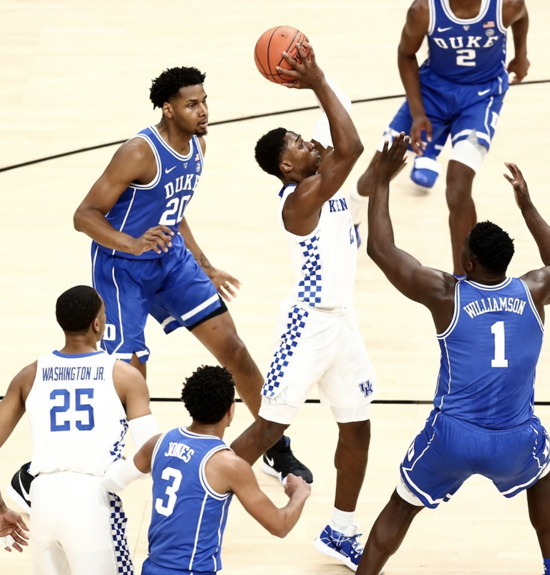 |
By the end of the night, the Wildcats barely were able to outscore the 83 points scored by Duke's top three freshmen. Duke won the game 118-84, the 34-point deficit being the largest defeat of any Calipari-coached Kentucky team and the largest Kentucky deficit since a 41-point loss to Vanderbilt under Billy Gillispie in 2008. The 118 points by Duke was the most scored by an opposing team since Rick Pitino's first season at Kentucky. The game was particularly sour for Kentucky fans, as they took advantage of the relatively short distance to Indianapolis for the game, but came away disappointed.
Noted Kentucky coach John Calipari after the game: "I told them, I said in one of the huddles, 'I think you guys thought this was going to be easy. . . I haven't had many of these kind of games, but I've had a few. The most that you can learn from this is they wanted it more than we wanted it."
Reid Travis was the only UK player made available to the media after the game. Despite the setback he was still upbeat for the season: "It was tough when you go down like that to start a game. . . Obviously we were all very excited, very hyped up for that game. it's kind of a blow to your chest. I feel like - as we mature as a team - we'll be able to take those blows and we'll flip it. We'll see that we're never really out of the game. Step up the defense, get a stop here, then to go the bucket at the other end. I think that will just be the maturity of our team."
In the end the Kentucky team did regroup and made a run in the NCAA tournament, before bowing out to the Auburn Tigers (a team they had already beaten twice in the regular season) in the NCAA Regional Final in overtime in Kansas City. This was the same ending as Duke, which was the #1 seeded team in the tournament. as the Blue Devils also lost in the NCAA Tournament regional finals, to Michigan State in Washington D.C.
[Boxscore] - 2018-19 Champions Classic
![]()
The series between these two schools has many common threads which run between the schools and from game to game. Whether you're talking about dramatic comebacks, last-second game-winning prayers, or stellar performances, these things have not only occurred in this series, but they've happened many times over. There have also been a few people who had some interesting interactions with the other program.
For example, some may not know that George Buchheit (mistakenly spelled Buckheit in some places), who coached at Kentucky in the 1920s, left UK at the end of the 1924 season and took a job as head coach of Duke (referred to as Trinity back then) and coached there for four years before Eddie Cameron's arrival in Durham. Buchheit was the first of what would be many Illinois graduates to coach at Kentucky in the 1920's, and institute what was known as the "Illinois" system, based on the systems Ralph Jones and later Craig Ruby utilized.
Speaking of Trinity College, some may not know that the religious aspect of Duke almost led a future Kentucky All-American John DeMoisey to enroll at Duke, until UK Coach Adolph Rupp found out about it put a stop to it late in the game. From Tev Laudemann's book (The Rupp Years) ...
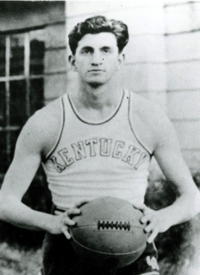 |
| John "Frenchy" DeMoisey |
In the summer of 1930, shortly after being named UK coach, Adolph Rupp visited DeMoisey. The coach found him working on the county roads outside Walton. Rupp asked the foreman for permission to talk to DeMoisey, and the two sat in the shade on the bank of a creek.
Rupp came straight to the point: did DeMoisey want to attend UK? DeMoisey explained his financial situation - he was one of eight children and he would have to work his way through school.
"I'll be back to see you again," Rupp promised.
A few weeks later Rupp went to the DeMoisey home. DeMoisey said he would like to attend UK but didn't have much money. This was before complete athletic scholarships at UK, but Rupp told him that tuition for the first semester was $31.50 and that he would try to find someone to pay the second semester. That clinched it.
The 6-foot-4-inch DeMoisey went on to become an All-American at Kentucky, and played in the 1932 game against Duke, scoring 8 points as a sophomore.
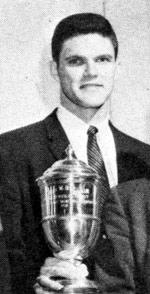 |
Parker returned the following morning, not content with letting the matter drop. Said Parker, "Got to the airport last night and just couldn't get on that plane. I said to myself, 'Buddy, you need to see Ed Beck again and save him from making the biggest mistake of his life ! There's only one school for him, the University of Kentucky !'"
Later Parker reportedly told Beck, "The state championship you won last night and the one you won two years ago were really wonderful, Ed, but they're nothing compared to the N.C.A.A. championship. Duke will never win one of those titles. Only Kentucky will win and you need to play on a team like that. You made all-state for three years and that's great congratulations. But that's nothing compared to making All-American, and Ed, you can do it ! .... But you won't do it at Duke, my friend. The nation and all the sports writers will be watching you at the University of Kentucky. That crowd last night was great, yeah. How many there ? Four or five thousand ? That's wonderful. At Duke you'll play before three, four thousand a game maybe. But at the University of Kentucky you'll play before standing room crowds every night, twelve or thirteen thousand people at the greatest basketball arena in the world, the University of Kentucky Memorial Coliseum !"
Beck did visit Durham, still intending to enroll at Duke, however by the end of his visit, he wasn't completely convinced and wanted to visit Vanderbilt and perhaps Kentucky before he made his final decision. When Beck didn't sign a grant-in-aid on the spot, Duke Coach Hal Bradley informed him that he would need to make a decision within ten days, since there were only a limited number of scholarships. When Beck returned to his school in Georgia, he found his high school coach accompanied by a stranger he had never met before. According to Beck in his book (A Love to Live By),
As I approached them Coach Faircloth shook my hand with a hearty "Welcome back !" and then began to introduce me to his companion. Before he could finish, the stranger broke in and said in a distinct midwestern accent: "Do you know who I am?"
I studied him for a moment and said: "No sir, I'm very sorry but I do not know your name."
"Well, son," he drawled, "that's too bad because when I tell you, you'll never forget it. It's going to become a very important name in your life." He took my hand in a vice-like grip, riveting me with his piercing gray eyes. Coach Faircloth was chuckling as I stood transfixed.
Finally I blurted: "Sir, who are you?"
"Adolph Rupp," he boomed. "Adolph Rupp of the University of Kentucky. The number one basketball team in the country this year. And don't you forget it!" I never did.
Beck went on to take a visit to Lexington. While he found the facilities and people to his liking, the experience was far different than what he found at other schools. For one thing, Rupp was not even present, being in Florida at the time watching spring training. Assistant Coach Harry Lancaster was the host. Instead of being guaranteed a starting position, Beck was cautioned he may not even be good enough to make the team. Beck wasn't even sure he had been offered a scholarship until he confirmed it just prior to returning to Georgia. When Beck inquired about a time limit for returning the grant-in-aid papers, Lancaster replied "Oh, our classes begin next fall around September 15th, so any time before then will be fine...No hurry." When Beck did send in his acceptance to UK, he found he had to apply his own stamp. Kentucky was the only school which hadn't included a stamped, self-addressed envelope.
As it turned out, Beck never did earn All-American honors at UK, but he did help the Wildcats win a national title in 1958.
Speaking of losing players to Duke, Kentucky lost a huge recruit in the early 1960's when Lexington Lafayette player Jeff Mullins decided to attend Duke instead of Kentucky. Although Kentucky recruited the 1960 Kentucky Mr. Basketball hard and UK usually landed whoever they really wanted in the state, Mullins was not the typical Kentucky high school boy growing up dreaming of playing for the Wildcats. His family transferred to Lexington to work at an IBM facility, and Mullins never really became immersed in the Kentucky aura.
Speaking of Mullins, he went to on become an All-American and successful college coach. While coaching UNC-Charlotte, he even came up against UK in the championship game of the 1987 UKIT, a tight game which was won by Kentucky 84-81, despite a super effort by UNC-Charlotte's Byron Dinkins and in part due to a controversial late-game call which found Dinkins pushed out of bounds by a UK player, and called for travelling by the official !
Mullins was a part of the Duke squad which met Kentucky in the 1963 Sugar Bowl Tournament. Mullins scored 26 points in the game, however as mentioned previously, it was the last-second heroics of Terry Mobley who sank a shot with time expiring to steal the victory.
Speaking of the buzzer beaters, this series had quite a few more. From Bucky Allen's shot in 1956, Vernon Hatton's heroics in 1957 and Sean Woods heave in 1992, only to be outdone by Christian Laettner's famous shot. There are other shots which could have been but missed their mark. Bobby Hurley's attempt at the end of regulation in 1992, William Avery's desperation shot at the end of the 1998 contest and Kyle Macy's ill-fated attempt against Vince Taylor in the NCAA Regionals.
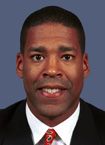 |
Taylor, meanwhile, attended Duke and had the opportunity to hurt Kentucky on more than one occasion. He scored 15 points in the game mentioned above, where he guarded Macy's last-second attempt. Taylor also played a big role in the earlier game that season, the inaugural Tip-Off Classic. In that game, he played 43 minutes and scored 14 points in the Duke win. Taylor would later become an assistant coach for Kentucky's arch-rival Louisville.
Speaking of the Tip-Off Classic, as mentioned previously, Duke and Kentucky met again in 1988-89 season for the 10th edition of the Classic. A player on the Duke squad that year was Quin Snyder and he would play an important role in the game, playing 34 minutes, scoring 10 points and handing out 5 assists. Snyder would later get into coaching and become the head coach at Missouri. Coach Snyder and Missouri met Kentucky in New Orleans in December 1999. Kentucky won the game easily that time.
Speaking of players competing against Kentucky and then coaching against them, not only did Snyder do this (along with Eddie Cameron as mentioned previously), but some may not know that Snyder's coach in college, Mike Krzyzewski also played against Kentucky when he was a student-athlete at Army in the late 1960's under Bob Knight. That game was held in December 1968 in the UKIT Championship game. Krzyzewski scored six points in what was an easy win for Kentucky. It also signified the first time Knight and UK Coach Adolph Rupp would meet on the floor. They would only meet one more time after Knight moved on to Indiana and before Rupp retired.
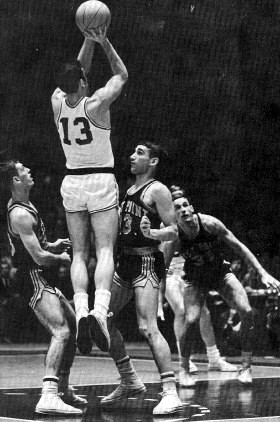 |
Speaking of Bob Knight, if you hadn't already guessed, he too also faced Kentucky as a player while he attended Ohio State. Those two games were both in the NCAA Regionals (and both won by OSU) and involved some powerhouse Ohio State teams, featuring All-Americans such as Jerry Lucas and John Havlicek. Knight was a role player, but he did see regular action for the Buckeyes. He was coached by Fred Taylor who (like Knight and Krzyzewski after him) won a national title. Incidentally, Taylor was coached at Ohio State by William Dye who in turn was coached by notable Buckeye coach Harold Olsen. Olsen in turn was coached by the legendary Walter "Doc" Meanwell of Wisconsin in the early part of the century. (It is noteworthy that when Rupp coached high school basketball in the northern Illinois city of Freeport in the 1920's, he used to travel to Madison Wisconsin to watch the Badgers play under Meanwell, and Rupp claims he learned much from the experiences.) This string of coaches illustrates just a part of what is an amazing coaching tree which involves some of the greatest coaches in NCAA basketball history.
Speaking of coaching family trees, two other major ones are represented in this rivalry between Kentucky and Duke. A minor influence was contributed by one of the major coaching trees in college basketball history. Kentucky's head coach in the mid-80's, Eddie Sutton, was a player on some of Hank Iba's Oklahoma State teams and is one of the standard-bearers for that coaching legacy. Historically, the major influence on the Kentucky side came from the Forest 'Phog' Allen coaching tree. Allen coached both Dean Smith and Adolph Rupp (the top two winningest coaches of all-time) along with many more outstanding coaches. (Of course Allen's coach at Kansas was none other than the inventor of basketball, Dr. James Naismith himself.) Joe B. Hall was a player under Rupp (for a short time before transferring to Sewanee) and was a long-time assistant coach at Kentucky.
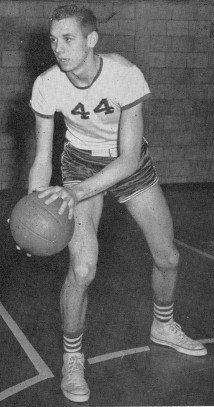 |
When the Duke position became available after Hal Bradley resigned, athletic director Eddie Cameron was interested in the young N.C. State assistant, but was concerned about the Moreland episode. The taint almost torpedoed Bubas' chances at the head position, but after extended conversations and assurances with persons close to the situation, the job was offered and the 32-year old Bubas accepted. Said Cameron to the media about the hire, "Gentlemen, this is Vic Bubas, our new basketball coach. We hope he is our coach forever." Bubas didn't stay as coach at Duke forever, but he did go on to post an outstanding 213-67 record at the school, before retiring from coaching in 1969.
Concerning Rupp, it may also surprise younger Duke fans to learn that he almost coached at Duke after he was forced to retire from UK in the early 1970's. Although elderly and with severe health problems dating back to the early 1940's, Rupp never willingly quit coaching and would have died on the bench if someone would have let him. From a passage in Russell Rice's book (Kentucky's Basketball Baron)...
Just before the 1972-73 season started, Bucky Waters resigned as Duke coach with one year remaining on a five-year contract. Duke's president was Terry Sanford, a former North Carolina governor who later became a U.S. Senator. Herky Rupp said Sanford and other school officials asked Rupp if he would like to coach the Blue Devils. Adolph said that would be fine. He planned to take Herky along as his chief assistant.
...
Two days before the start of basketball practice, Rupp's farm manager (Carl Yazell) died. The farm was a substantial investment, and there was no one to run it. Duke gave Rupp one week to straighten out his business affairs. Unable to find anyone that quickly to tend to the farm, he told them to go ahead and hire someone else.
According to another article, the offer came about when Duke Athletic Director Carl James asked Rupp about Georgia Coach Ken Rosemond who had listed Rupp as one of his references. As they talked about the vacant position at Duke, Rupp reportedly told James "Why not me?"
After Yazell's death, Rupp reportedly said, "I just couldn't work it out, although I hated to say no. I couldn't throw my cards on the table without knowing who was going to run my farm. I couldn't sell my cattle or strip tobacco from down there in Durham."
Concerning coaching in Durham at his advanced age, Rupp said "I still have the same old desired I had at 40, and I wanted to get with it against Norman (Sloan) at N.C. State and Dean (Smith) at North Carolina."
"Hell, I coached against all of them. I was willing to take my lumps, but I was gonna give them a run for their money."
As it turned out, Rupp was himself in poor health and slowly receded out of the public eye. He was able to live long enough to see a new arena built in downtown Lexington and dedicated in his name. During the dedication ceremony, Rupp exclaimed about the newly built Rupp Arena, "This is the best place in the world."
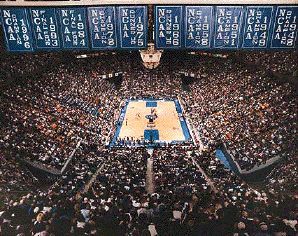 |
| Rupp Arena |
The following year on December 10, 1977, Rupp would die in a Lexington hospital fighting cancer. At the time and halfway across the country, the Kentucky team was at Phog Allen Fieldhouse playing his alma mater, Kansas, in a game dedicated to the man.
Speaking of Rupp Arena, it was there that Duke had to play in the 1998 NCAA first and second rounds, despite coach Mike Krzyzewski's objections over his team's placement by the NCAA Selection Committee. The Blue Devils had a chance to stay in their preferred region as a #1 seed in the tournament, however they were blown out in the ACC tournament and the Tar Heels of North Carolina won the 'right' to play in the East Region with early round games in Hartford Connecticut. The prize was the Regionals which were to be held in nearby Greensboro North Carolina.
Duke received the second-best region (the South in St. Petersburg) but instead of their desired subregional (Atlanta), the Blue Devils were placed in Lexington, KY. The #2 seeded Wildcats (who could not play in Lexington due to NCAA regulations) were instead given the Atlanta site. The day after Duke's ACC tournament loss, a disappointed Krzyzewski complained about the seeding in a press conference and hinted at a theory often-championed by UNC's Dean Smith of 'natural regions,' a concept foreign to places outside of Tobacco Road, places which didn't have the luxury of having a first round site in their back yard every couple of years (ie Winston-Salem, Greensboro, Charlotte).
During the press conference, a question was asked of Krzyzewski about what his anticipated reception would be in Lexington. He answered truthfully and wondered aloud whether UK fans would still be resentful of the game in 1992 and made a note that if the seeding held, Kentucky and Duke were slated for a rematch in St. Petersburg. Although that was what he was thinking, Krzyzewski's remarks didn't come off well when he verbalized them to the nation. At one point Krzyzewski lamented of the potential time in Lexington,
"For four or five days, we're there not necessarily enjoying the NCAA," he said. "Do you take your people out to restaurants where people will say 'Remember '92?'"
The national press, which was already slightly amused by Krzyzewski's resurrection of Smith's 'natural regions' theory, was completely baffled by the idea that the NCAA Tournament was supposed to cater to the psyche's of a group of battle-hardened athletes who trained year-round to thrive in less-than-ideal conditions. Kentucky fans found Krzyzewski's protestations ridiculous, knowing that just the previous year, the Wildcats had to play in the home arena of the #1-seeded Utah team for the first and second round before going on to meet Utah in the Regional Finals, yet the 'issue' never came up that time. The national press largely panned Krzyzewski's concerns as needless whining.
Even before the Duke team arrived in Lexington, the dye was cast. Even if UK fans didn't have a strong reason to dislike Duke before the tournament, Krzyzewski's remarks about the host city before he even arrived ensured that they would receive a chilly reception, which he did. Not that it made much of a difference. Duke decimated Radford in the first round, before handling former UK-coach Eddie Sutton (probably the one man in the tournament reviled more in Lexington than Krzyzewski) and his Oklahoma State team the following game. This led to what would eventually be the much-anticipated rematch in St. Petersburg.
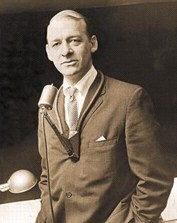 |
"I wanted to pick you guys [Ledford and Ralph Hacker] out because all the Kentucky fans would be listening and just to say how much empathy we have as a staff and team for the Kentucky kids..they..they were absolutely sensational." - Mike Krzyzewski, March 28, 1992.
It was a gesture of goodwill appreciated by many Kentucky fans and remembered for many years after. Unfortunately, the warm feelings this gesture created were largely lost after Krzyzewski's comments prior to the 1998 tournament, and whatever reception he and his team would have received will never be known.
Speaking of Cawood Ledford, the call he made in the 1992 game was the last UK game the Kentucky legend called. He went on to broadcast the NCAA Final Four from Indianapolis, as part of a nationally-broadcast feed of the game. As well-wishers came up to congratulate him on his final game in Minneapolis, he said later he was thinking "How could I tell them my season ended last week?"
Speaking of the 1992 game in Philadelphia, when Duke All-American Christian Laettner went a perfect 10-10 from the field and 10-10 from the line in the 1992 NCAA regional, it was in some ways reminiscent of Kentucky's All-American Paul McBrayer who reportedly went a perfect 10-of-10 from the line in the Southern Conference Tournament, which included going 2-of-2 in that very first match-up between the two schools way back in 1930.
![]()
Please note that the following reference materials were consulted for the above. 1.) Lexington Herald 2.) Louisville Courier Journal 3.) New York Times 4.) Big Blue Machine by Russell Rice 5.) The Winning Tradition by Bert Nelli 6.) 1906-1986 Duke Basketball - An Illustrated History by Bill Brill 7.) A Love to Live By by Ed Beck 8.) Duke University library on-line archives 9.) "College Basketball: Wooden Not About to Retire" Sporting News December 8, 1973 pg 5 10.) "Rupp Declines, McGeachy Doesn't" Burlington (N.C.) Times News October 19, 1973 among others.
Return to Kentucky Rivalries, Duke Series Results, statistics, teams, opponents, players, coaches, opposing coaches, games or search this site.
Page written by Jon Scott. Please with any corrections or additional information.
Last Updated November 7, 2021